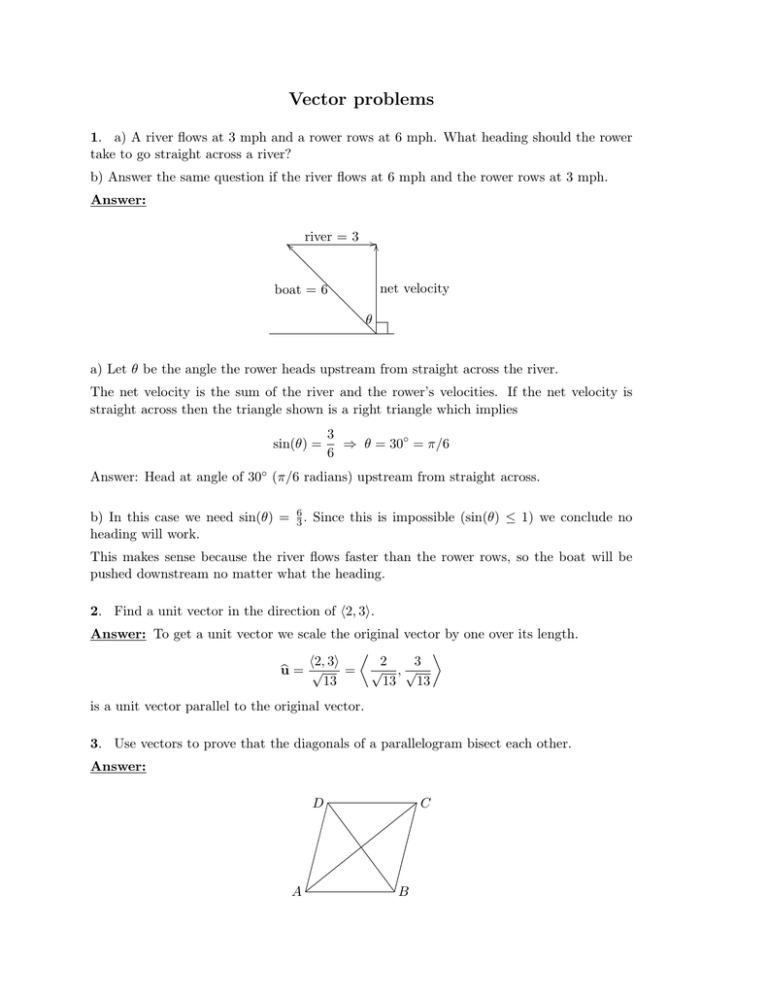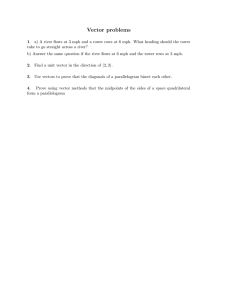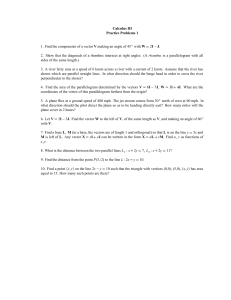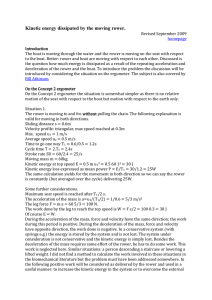Document 13406061
advertisement

Vector problems 1. a) A river flows at 3 mph and a rower rows at 6 mph. What heading should the rower take to go straight across a river? b) Answer the same question if the river flows at 6 mph and the rower rows at 3 mph. Answer: river = 3 � � net velocity boat = 6 θ a) Let θ be the angle the rower heads upstream from straight across the river. The net velocity is the sum of the river and the rower’s velocities. If the net velocity is straight across then the triangle shown is a right triangle which implies sin(θ) = 3 ⇒ θ = 30◦ = π/6 6 Answer: Head at angle of 30◦ (π/6 radians) upstream from straight across. b) In this case we need sin(θ) = heading will work. 6 3. Since this is impossible (sin(θ) ≤ 1) we conclude no This makes sense because the river flows faster than the rower rows, so the boat will be pushed downstream no matter what the heading. 2. Find a unit vector in the direction of �2, 3�. Answer: To get a unit vector we scale the original vector by one over its length. � � �2, 3� 2 3 �= √ u = √ ,√ 13 13 13 is a unit vector parallel to the original vector. 3. Use vectors to prove that the diagonals of a parallelogram bisect each other. Answer: D A C B We need to show that the two diagonals intersect at their mutual midpoints. Said differently we need to show that the midpoints of AC and BD are, in fact, the same point. Let M1 be the midpoint of AC and M2 be the midpoint of BD. Rephrasing our goal yet −−−→ −−−→ again, we will show M1 = M2 by showing AM1 = AM2 . Now, using vectors we have −−−→ 1 −−→ AM1 = AC 2 We need to use the fact that ABCD is a parallelogram. From this we get −−→ −−→ −−→ 1 −−→ 1 −−→ 1 −−→ 1 −−→ AB = DC ⇒ AB = AB + AB = AB + DC 2 2 2 2 −−−→ We use this to write AM2 in terms of A, B, C, D. −−−→ −−→ 1 −−→ 1 −−→ 1 −−→ 1 −−→ 1 −−→ −−→ −−→ 1 −−→ AM2 = AB + BD = AB + DC + BD = (AB + BD + DC) = AC 2 2 2 2 2 2 −−−→ −−−→ We have shown AM1 = AM2 , so we are done. 4. Prove using vector methods that the midpoints of the sides of a space quadrilateral form a parallelogram Answer: Let A, B, C, D be the four sides; then if the vectors are oriented as shown in the figure below we have A + B = C + D. 1 1 The vector from the midpoint of A to the midpoint of C is C − A; similarly the vector 2 2 1 1 joining the midpoints of the other two sides is B − D. Then 2 2 1 1 A + B = C + D ⇒ C − A = B − D ⇒ (C − A) = (B − D). 2 2 Thus two opposite sides are equal and parallel, which shows the figure is a parallelogram. D C B A Some note about finding these proofs: 1. You need to use the hypotheses. For example, in this problem a key step made use of the fact that ABCD is a parallelogram. 2. You should not expect to see the proofs immediately. Rather you will generally need to play around with the figure. 3. After arriving at a proof you should see if you can clean it up or simplify it. MIT OpenCourseWare http://ocw.mit.edu 18.02SC Multivariable Calculus Fall 2010 For information about citing these materials or our Terms of Use, visit: http://ocw.mit.edu/terms.




